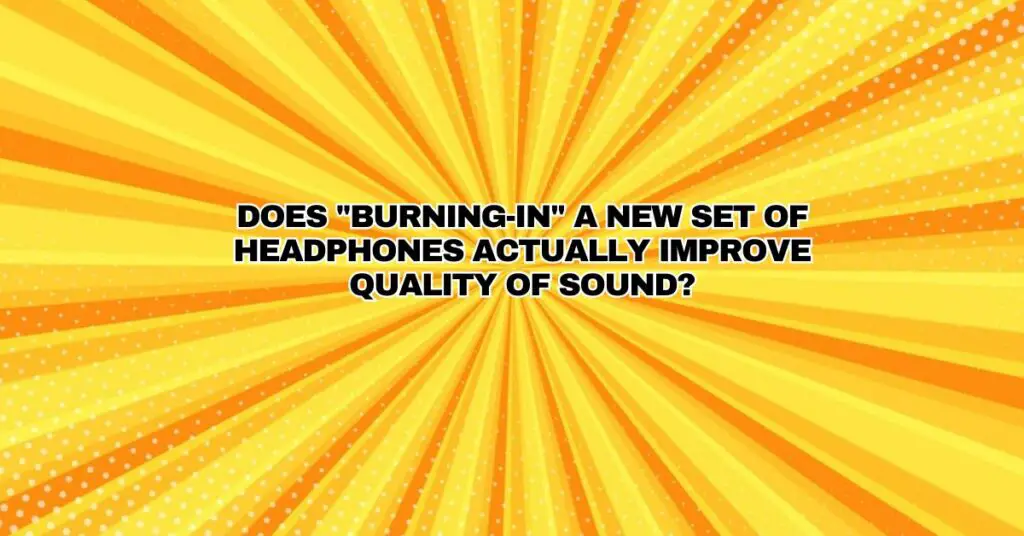The concept of “burning in” headphones has been a topic of debate and discussion among audiophiles and music enthusiasts for years. Some claim that subjecting new headphones to an extended period of playback can significantly enhance their sound quality, while others remain skeptical. In this comprehensive article, we will explore the practice of burning in headphones, the science behind it, and whether it can genuinely improve the quality of sound.
What Is Burning-In Headphones?
“Burning in” headphones, also known as “breaking in” or “running in,” involves playing audio through a new pair of headphones for an extended period, often ranging from several hours to several days. The idea is to allow the headphone components to settle and adapt to the electrical signals, theoretically leading to improved sound quality.
The Science Behind Burning-In
The concept of burning in headphones is rooted in the belief that the mechanical components, such as the diaphragm, drivers, and cables, need time to reach their optimal performance. Proponents of this practice argue that the following changes can occur during the burn-in process:
- Driver Flexibility: The diaphragm and drivers in headphones may become more flexible, leading to improved responsiveness and a broader frequency range.
- Removal of Residual Manufacturing Substances: Some headphones may contain residual manufacturing substances that can affect the sound. Extended use is thought to help eliminate these substances.
- Driver Alignment: It is believed that the alignment of the drivers can settle over time, resulting in better synchronization of audio signals and improved stereo imaging.
- Cable Properties: Headphone cables may become more pliable and conductive with extended use, enhancing signal transmission.
The Controversy Surrounding Burning-In
While some listeners swear by the practice of burning in headphones, there is a significant amount of skepticism and debate within the audio community. The controversy arises from the following points:
- Lack of Scientific Evidence: The scientific evidence supporting the effectiveness of burning in headphones is limited. Controlled studies with conclusive results are scarce, and much of the evidence remains anecdotal.
- Varied Results: Listeners’ experiences with burning in headphones vary widely. Some report noticeable improvements, while others detect little to no change in sound quality.
- Placebo Effect: Some argue that the perceived improvements in sound quality could be due to the placebo effect—listeners expect the headphones to sound better after burn-in, and their expectations influence their perception.
- Differences in Headphone Types: Not all headphones may respond the same way to burn-in, and the impact, if any, may vary depending on the design and components of the headphones.
When Does Burning In Help?
There are instances where burning in headphones may have a more perceptible effect:
- Dynamic Drivers: Headphones with dynamic drivers, which are more mechanical in nature, may show more pronounced changes over time.
- Suboptimal Initial Sound: If your headphones initially sound subpar, burning them in may help improve their performance to some extent.
When Burning In May Not Help:
- Balanced Armature Drivers: Headphones with balanced armature drivers, commonly found in in-ear monitors, are less likely to experience significant changes through burn-in.
- Higher-End Headphones: Premium, well-engineered headphones are designed for optimal performance from the start, and burning them in might not yield substantial improvements.
Conclusion
The practice of burning in headphones remains a subject of debate, with proponents advocating for its potential to enhance sound quality and skeptics questioning its validity. While some listeners may report positive experiences, the scientific evidence is inconclusive, and results can be inconsistent.
Ultimately, whether or not you choose to burn in your headphones depends on your personal preferences and the specific headphones you own. If you believe that burn-in improves the sound quality or you notice positive changes, there’s no harm in giving it a try. However, keep in mind that for high-quality headphones, the impact of burn-in might be minimal, and it should not be seen as a substitute for choosing headphones designed to meet your sound preferences from the outset.


